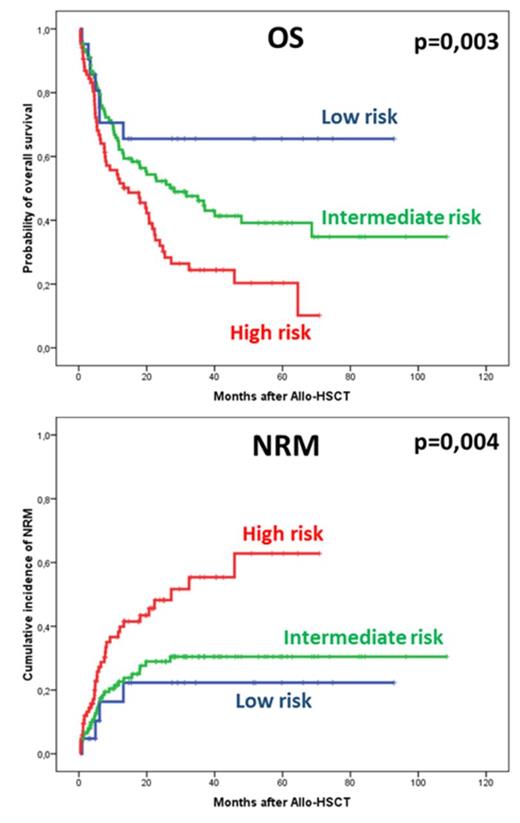Abstract
Introduction
Allogeneic hematopoietic stem cell transplantation (allo-HSCT) from unrelated donors has been increasingly used worldwide in the last decade in patients with hematological malignancies when HLA-identical sibling donors are unavailable. Identification of the HLA locus matching at the allele level is important in optimizing transplantation outcomes by minimizing non-relapse mortality (NRM) as well as in enhancing the graft-versus-leukemia effect. It has been demonstrated that patients with HSC donors matched on HLA-A, -B, -C, -DRB1, and -DQB1 alleles can have different outcomes if considering matching on HLA-DPB1 allele. HLA-DPB1 mismatches based on T-cell-epitope groups could identify mismatches that might be tolerated (permissive) and those that would negatively impact transplantation outcomes (non-permissive).
We conducted this study to evaluate the impact of HLA matching degree between patient and HSC donor including HLA-DPB1, taking into account the other impacting variables in the allo-HSCT settings.
Material and methods
A total of 235 patients who received allo-HSCT at our center between January 2005 and December 2014 with a full donor/recipient HLA class I and II locus available data were included, 131 (56%) were males, the median age at allo-HSCT was 50 years (range: 18-69). There was 123 (53%) acute leukemia (93 AML, 30 ALL), 24 (10%) MDS, 35 (15%) multiple myeloma, 20 (8%) NHL, 7 (3%) Hodgkin's disease, 10 (4%) myeloproliferative neoplasms, 13 (6%) CML, and 3 (1%) CLL. One hundred and nineteen patients (51%) received myeloablative conditioning (MAC) and 116 (49%) received reduced intensity conditioning (RIC). Disease status at allo-HSCT was complete remission (CR) in 144 (61%) patients and less than CR in 91 (39%). HSC donor was 10/10 HLA matched unrelated (MUD) for 162 (69%) (80 PBSC and 93 BM), among them 21 (9%) were matched for HLA-DPB1, 41 (18%) had permissive mismatch and 100 (42%) had non-permissive mismatch; while 73 (31%) had 9/10 HLA mismatched donor MMUD (48 PBSC and 25 BM), among them, 7 (3%) were matched for HLA-DPB1, 12 (5%) had permissive mismatch and 54 (23%) had non-permissive mismatch; 110 (47%) were ABO compatible, 58 (24%) had minor incompatibility and 67 (29%) had major incompatibility. For sex mismatching, in 33 (14%) cases, it was female donor to a male patient.
Results
After a median follow-up for surviving patients of 29 months (range: 4-108), patients with 10/10 HLA MUD had better overall survival (OS) than those with 9/10 MMUD without considering the HLA-DPB1 matching, with 2 years OS probability of 51% vs 35% respectively (p=0.09), which was reflected by a lower NRM at 2 years of 29% vs 42% (p=0.07). When considering the HLA-DPB1 matching, we found comparable outcomes in terms of OS and NRM for: 1) 10/10 HLA MUD - DPB1 matched vs 10/10 HLA MUD - DPB1 permissive mismatched, 2) 10/10 HLA MUD - non-permissive DPB1 mismatched vs 9/10 HLA MMUD - DPB1 matched, 3) 9/10 HLA MMUD - DPB1 matched vs 9/10 HLA MMUD - DPB1 permissive mismatched; all these 3 groups were not significantly different between each other expect for a last group which included 9/10 HLA MMUD with non-permissive DPB1 mismatch, this group had worse OS and NRM compared to all others with 2 years rates of 34% vs 49% (p=0.05) and 47% vs 29% (p=0.04) respectively. In multivariate analysis, patient age (>50 years), disease status (less than CR), HLA matching (9/10 HLA MUD non-permissive DPB1) and sex mismatching (female donor to male patient) were significantly impacting OS and NRM. We included all these variables in a risk score: age < 50 years= 0, > 50 years= 1; CR= 0, less than CR= 1; HLA 10/10 (matched on DPB1) or HLA 10/10 with permissive MM on DPB1= 0; HLA 10/10 with non-permissive MM on DPB1 or HLA 9/10 (matched on DPB1 or with permissive MM on DPB1)=1; HLA 9/10 with non-permissive MM on DPB1=2; for sex matching, female donor to male patient=1, all other= 0. The risk score distinguished low risk patients (total score=0), intermediate (total score=1 or 2) and high risk (total score >2) with 2 years OS and NRM rates of 66%, 52%, 30% (p=0.003) and 22%, 29% 48% (p=0.004) respectively.
Conclusion
MMUD with non-permissive T-cell-epitope mismatch at HLA-DPB1 should be avoided due to increased rates of NRM. The risk score combining HLA matching with age, disease status and sex matching is very helpful for daily clinical practice offering patients better treatment strategy.
Nicolini:Bristol-Myers Squibb: Honoraria, Membership on an entity's Board of Directors or advisory committees, Speakers Bureau; Ariad Pharmaceuticals: Honoraria, Membership on an entity's Board of Directors or advisory committees, Speakers Bureau; Novartis: Honoraria, Membership on an entity's Board of Directors or advisory committees, Research Funding, Speakers Bureau.
Author notes
Asterisk with author names denotes non-ASH members.


This feature is available to Subscribers Only
Sign In or Create an Account Close Modal